Vintage Wines: Analysis of Leadership and Organisational Change Report
VerifiedAdded on 2022/11/26
|13
|2993
|131
Report
AI Summary
This report analyzes the organizational crisis faced by Vintage Wines, a premium Australian wine producer, from 2008 to 2010. The report explores the impact of a new CEO's change management strategies, including overseas expansion and personnel changes, and their effects on employee morale, communication, and production. It examines the importance of effective communication in facilitating organizational change, highlighting the negative consequences of poor communication between leadership and employees, as well as the role of leadership in successfully implementing change. The report also discusses the effectiveness of employee feedback and corrective action in response to organizational changes. Secondary data collection methods are used to evaluate the company's challenges and offer recommendations for improved change management, communication, and leadership to achieve sustainable business success.

Group Case Report
Paraphrase This Document
Need a fresh take? Get an instant paraphrase of this document with our AI Paraphraser
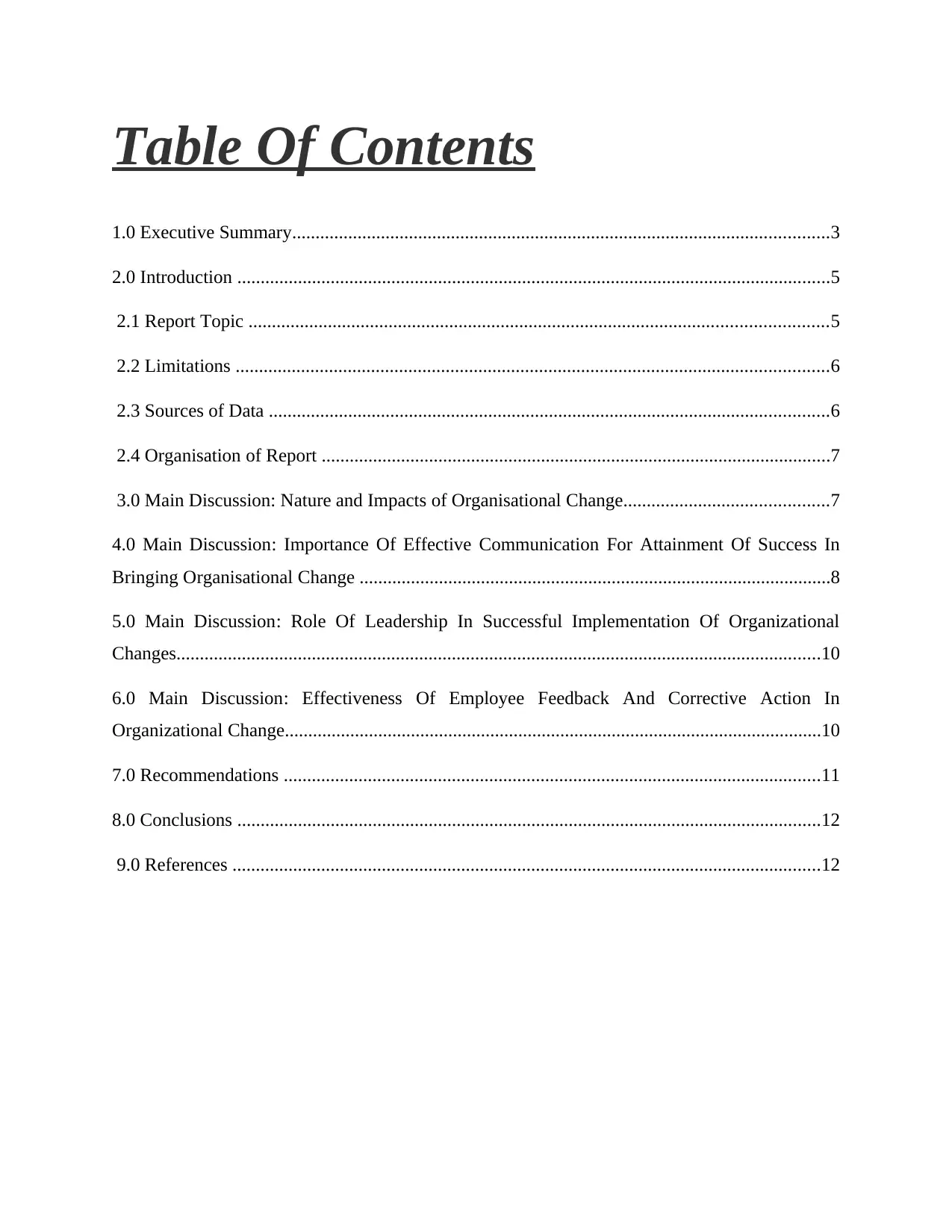
Table Of Contents
1.0 Executive Summary...................................................................................................................3
2.0 Introduction ...............................................................................................................................5
2.1 Report Topic ............................................................................................................................5
2.2 Limitations ...............................................................................................................................6
2.3 Sources of Data ........................................................................................................................6
2.4 Organisation of Report .............................................................................................................7
3.0 Main Discussion: Nature and Impacts of Organisational Change............................................7
4.0 Main Discussion: Importance Of Effective Communication For Attainment Of Success In
Bringing Organisational Change .....................................................................................................8
5.0 Main Discussion: Role Of Leadership In Successful Implementation Of Organizational
Changes..........................................................................................................................................10
6.0 Main Discussion: Effectiveness Of Employee Feedback And Corrective Action In
Organizational Change...................................................................................................................10
7.0 Recommendations ...................................................................................................................11
8.0 Conclusions .............................................................................................................................12
9.0 References ..............................................................................................................................12
1.0 Executive Summary...................................................................................................................3
2.0 Introduction ...............................................................................................................................5
2.1 Report Topic ............................................................................................................................5
2.2 Limitations ...............................................................................................................................6
2.3 Sources of Data ........................................................................................................................6
2.4 Organisation of Report .............................................................................................................7
3.0 Main Discussion: Nature and Impacts of Organisational Change............................................7
4.0 Main Discussion: Importance Of Effective Communication For Attainment Of Success In
Bringing Organisational Change .....................................................................................................8
5.0 Main Discussion: Role Of Leadership In Successful Implementation Of Organizational
Changes..........................................................................................................................................10
6.0 Main Discussion: Effectiveness Of Employee Feedback And Corrective Action In
Organizational Change...................................................................................................................10
7.0 Recommendations ...................................................................................................................11
8.0 Conclusions .............................................................................................................................12
9.0 References ..............................................................................................................................12

1.0 Executive Summary
The process of organizational change is a vital issue for the business organizations and takes
place within the organizations due to the ever changing business environment and requirements
of the clients and customers. The overall process of organizational change remains targetted
towards the optimization of the business performance and attainment of success and
competitiveness by the business. The present task will emphasize on the organizational change in
Vintage Wines which was a popular business in Australia as they have maintained the quality of
their product over every other factors. However due to the changes in the business environment it
has become difficult for the business to sustain in the market and for that matter they have
appointed a new CEO. The CEO has planned and implemented the change management within
the organization that has initially been successful for the business and have tripled the sales in a
year. However, there have been other problems in business operations that are yet needed to be
addressed by the organization. The present task will discuss various scopes and opportunities that
are available for the organization for bringing effectiveness to the organizational change and
making the organization attain the competitive edge within the global market.
The process of organizational change is a vital issue for the business organizations and takes
place within the organizations due to the ever changing business environment and requirements
of the clients and customers. The overall process of organizational change remains targetted
towards the optimization of the business performance and attainment of success and
competitiveness by the business. The present task will emphasize on the organizational change in
Vintage Wines which was a popular business in Australia as they have maintained the quality of
their product over every other factors. However due to the changes in the business environment it
has become difficult for the business to sustain in the market and for that matter they have
appointed a new CEO. The CEO has planned and implemented the change management within
the organization that has initially been successful for the business and have tripled the sales in a
year. However, there have been other problems in business operations that are yet needed to be
addressed by the organization. The present task will discuss various scopes and opportunities that
are available for the organization for bringing effectiveness to the organizational change and
making the organization attain the competitive edge within the global market.
⊘ This is a preview!⊘
Do you want full access?
Subscribe today to unlock all pages.

Trusted by 1+ million students worldwide
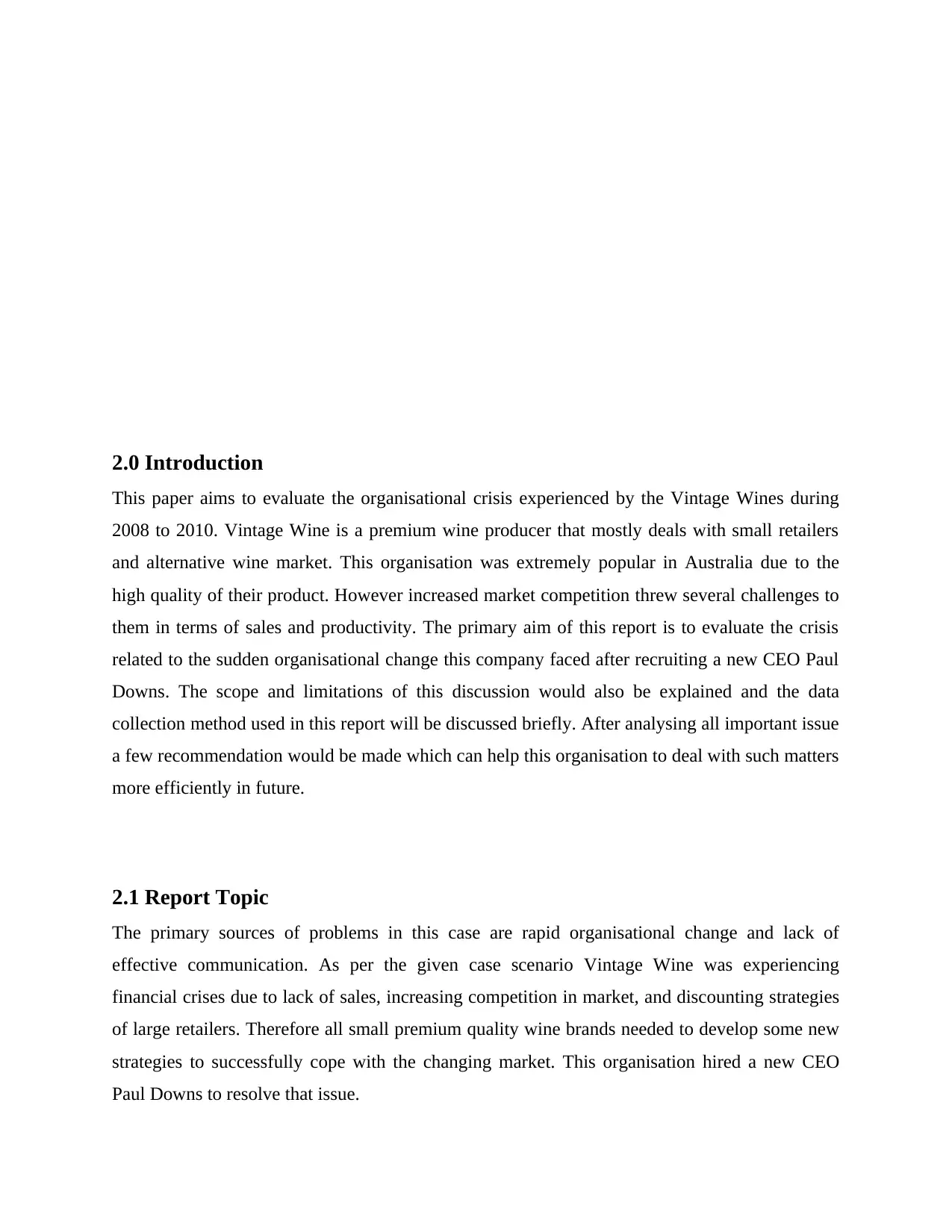
2.0 Introduction
This paper aims to evaluate the organisational crisis experienced by the Vintage Wines during
2008 to 2010. Vintage Wine is a premium wine producer that mostly deals with small retailers
and alternative wine market. This organisation was extremely popular in Australia due to the
high quality of their product. However increased market competition threw several challenges to
them in terms of sales and productivity. The primary aim of this report is to evaluate the crisis
related to the sudden organisational change this company faced after recruiting a new CEO Paul
Downs. The scope and limitations of this discussion would also be explained and the data
collection method used in this report will be discussed briefly. After analysing all important issue
a few recommendation would be made which can help this organisation to deal with such matters
more efficiently in future.
2.1 Report Topic
The primary sources of problems in this case are rapid organisational change and lack of
effective communication. As per the given case scenario Vintage Wine was experiencing
financial crises due to lack of sales, increasing competition in market, and discounting strategies
of large retailers. Therefore all small premium quality wine brands needed to develop some new
strategies to successfully cope with the changing market. This organisation hired a new CEO
Paul Downs to resolve that issue.
This paper aims to evaluate the organisational crisis experienced by the Vintage Wines during
2008 to 2010. Vintage Wine is a premium wine producer that mostly deals with small retailers
and alternative wine market. This organisation was extremely popular in Australia due to the
high quality of their product. However increased market competition threw several challenges to
them in terms of sales and productivity. The primary aim of this report is to evaluate the crisis
related to the sudden organisational change this company faced after recruiting a new CEO Paul
Downs. The scope and limitations of this discussion would also be explained and the data
collection method used in this report will be discussed briefly. After analysing all important issue
a few recommendation would be made which can help this organisation to deal with such matters
more efficiently in future.
2.1 Report Topic
The primary sources of problems in this case are rapid organisational change and lack of
effective communication. As per the given case scenario Vintage Wine was experiencing
financial crises due to lack of sales, increasing competition in market, and discounting strategies
of large retailers. Therefore all small premium quality wine brands needed to develop some new
strategies to successfully cope with the changing market. This organisation hired a new CEO
Paul Downs to resolve that issue.
Paraphrase This Document
Need a fresh take? Get an instant paraphrase of this document with our AI Paraphraser
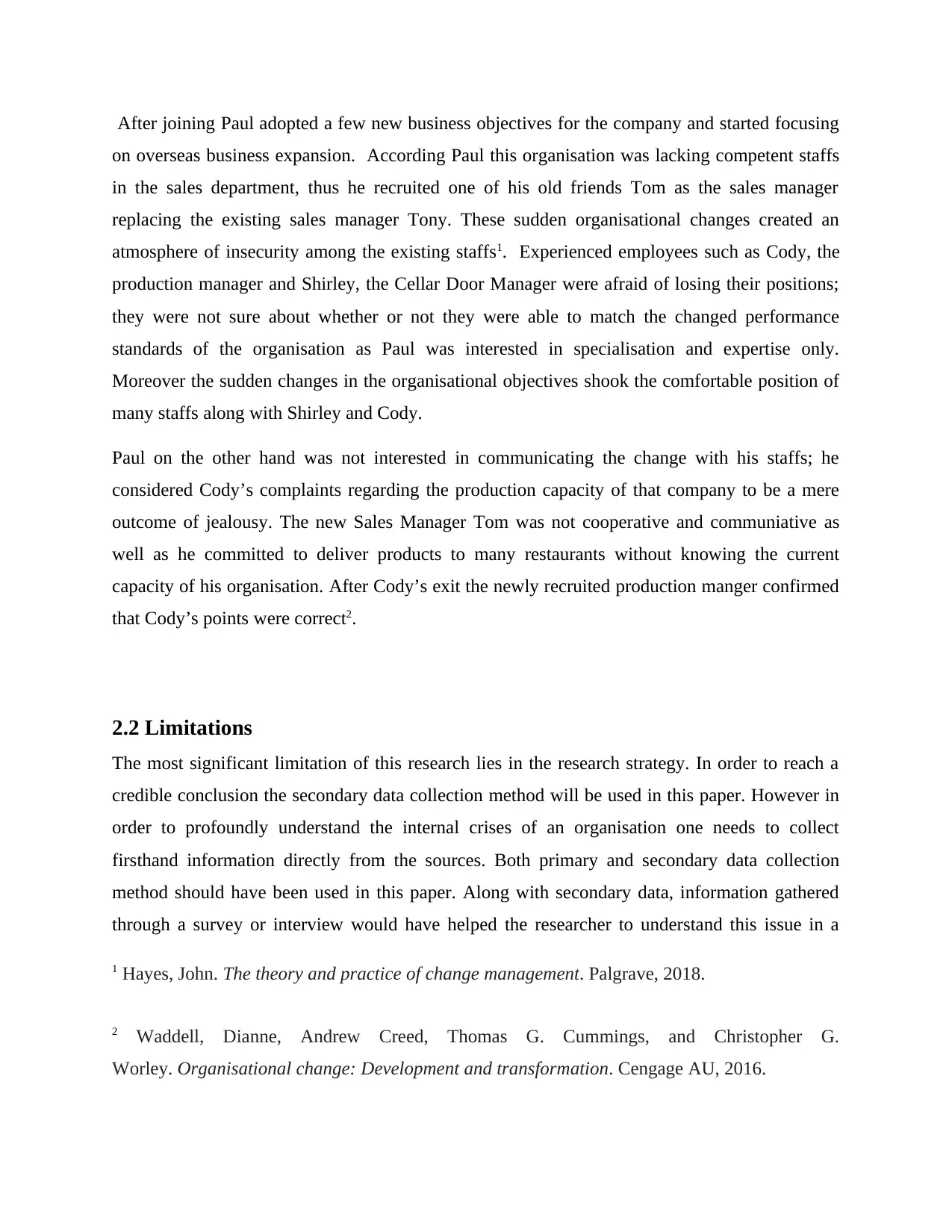
After joining Paul adopted a few new business objectives for the company and started focusing
on overseas business expansion. According Paul this organisation was lacking competent staffs
in the sales department, thus he recruited one of his old friends Tom as the sales manager
replacing the existing sales manager Tony. These sudden organisational changes created an
atmosphere of insecurity among the existing staffs1. Experienced employees such as Cody, the
production manager and Shirley, the Cellar Door Manager were afraid of losing their positions;
they were not sure about whether or not they were able to match the changed performance
standards of the organisation as Paul was interested in specialisation and expertise only.
Moreover the sudden changes in the organisational objectives shook the comfortable position of
many staffs along with Shirley and Cody.
Paul on the other hand was not interested in communicating the change with his staffs; he
considered Cody’s complaints regarding the production capacity of that company to be a mere
outcome of jealousy. The new Sales Manager Tom was not cooperative and communiative as
well as he committed to deliver products to many restaurants without knowing the current
capacity of his organisation. After Cody’s exit the newly recruited production manger confirmed
that Cody’s points were correct2.
2.2 Limitations
The most significant limitation of this research lies in the research strategy. In order to reach a
credible conclusion the secondary data collection method will be used in this paper. However in
order to profoundly understand the internal crises of an organisation one needs to collect
firsthand information directly from the sources. Both primary and secondary data collection
method should have been used in this paper. Along with secondary data, information gathered
through a survey or interview would have helped the researcher to understand this issue in a
1 Hayes, John. The theory and practice of change management. Palgrave, 2018.
2 Waddell, Dianne, Andrew Creed, Thomas G. Cummings, and Christopher G.
Worley. Organisational change: Development and transformation. Cengage AU, 2016.
on overseas business expansion. According Paul this organisation was lacking competent staffs
in the sales department, thus he recruited one of his old friends Tom as the sales manager
replacing the existing sales manager Tony. These sudden organisational changes created an
atmosphere of insecurity among the existing staffs1. Experienced employees such as Cody, the
production manager and Shirley, the Cellar Door Manager were afraid of losing their positions;
they were not sure about whether or not they were able to match the changed performance
standards of the organisation as Paul was interested in specialisation and expertise only.
Moreover the sudden changes in the organisational objectives shook the comfortable position of
many staffs along with Shirley and Cody.
Paul on the other hand was not interested in communicating the change with his staffs; he
considered Cody’s complaints regarding the production capacity of that company to be a mere
outcome of jealousy. The new Sales Manager Tom was not cooperative and communiative as
well as he committed to deliver products to many restaurants without knowing the current
capacity of his organisation. After Cody’s exit the newly recruited production manger confirmed
that Cody’s points were correct2.
2.2 Limitations
The most significant limitation of this research lies in the research strategy. In order to reach a
credible conclusion the secondary data collection method will be used in this paper. However in
order to profoundly understand the internal crises of an organisation one needs to collect
firsthand information directly from the sources. Both primary and secondary data collection
method should have been used in this paper. Along with secondary data, information gathered
through a survey or interview would have helped the researcher to understand this issue in a
1 Hayes, John. The theory and practice of change management. Palgrave, 2018.
2 Waddell, Dianne, Andrew Creed, Thomas G. Cummings, and Christopher G.
Worley. Organisational change: Development and transformation. Cengage AU, 2016.

deeper way. However this strategy cannot be applied as the entire course of incidents took place
before 2010.
2.3 Sources of Data
This paper will mostly use credible secondary information to achieve the report objectives.
Various journals, books, news paper reports and articles will be used by the researcher. Online
sources will be accessed as well for collecting wide range of reliable information. Secondary
data collection method would enable the researcher to take various aspects associated with the
case scenario into consideration.
2.4 Organisation of Report
This report will focus on three major areas to resolve the primary problems identified in the
case scenario. The first section will discuss the nature and impact of sudden organisational
change on the employees. The second section will explain the importance of effective
communication in efficiently carrying out an organisational change. The third section would
evaluate leadership roles in implementing organisational change successfully. And finally the
last section will consider the effectiveness of employee feedback and corrective action in
response to the organizational change.
3.0 Main Discussion: Nature and Impacts of Organisational Change
Organisational change can be defined as a process that enables organisations to change their
strategies, structure, methods of operations, organisational culture and so on. Various theories
can be used to explain the reason behind organisational change. However the failure-induced
theory of change will be most applicable to the given case scenario; according to this theory
organisations change their strategies, culture, technology and other characteristics when they fail
before 2010.
2.3 Sources of Data
This paper will mostly use credible secondary information to achieve the report objectives.
Various journals, books, news paper reports and articles will be used by the researcher. Online
sources will be accessed as well for collecting wide range of reliable information. Secondary
data collection method would enable the researcher to take various aspects associated with the
case scenario into consideration.
2.4 Organisation of Report
This report will focus on three major areas to resolve the primary problems identified in the
case scenario. The first section will discuss the nature and impact of sudden organisational
change on the employees. The second section will explain the importance of effective
communication in efficiently carrying out an organisational change. The third section would
evaluate leadership roles in implementing organisational change successfully. And finally the
last section will consider the effectiveness of employee feedback and corrective action in
response to the organizational change.
3.0 Main Discussion: Nature and Impacts of Organisational Change
Organisational change can be defined as a process that enables organisations to change their
strategies, structure, methods of operations, organisational culture and so on. Various theories
can be used to explain the reason behind organisational change. However the failure-induced
theory of change will be most applicable to the given case scenario; according to this theory
organisations change their strategies, culture, technology and other characteristics when they fail
⊘ This is a preview!⊘
Do you want full access?
Subscribe today to unlock all pages.

Trusted by 1+ million students worldwide
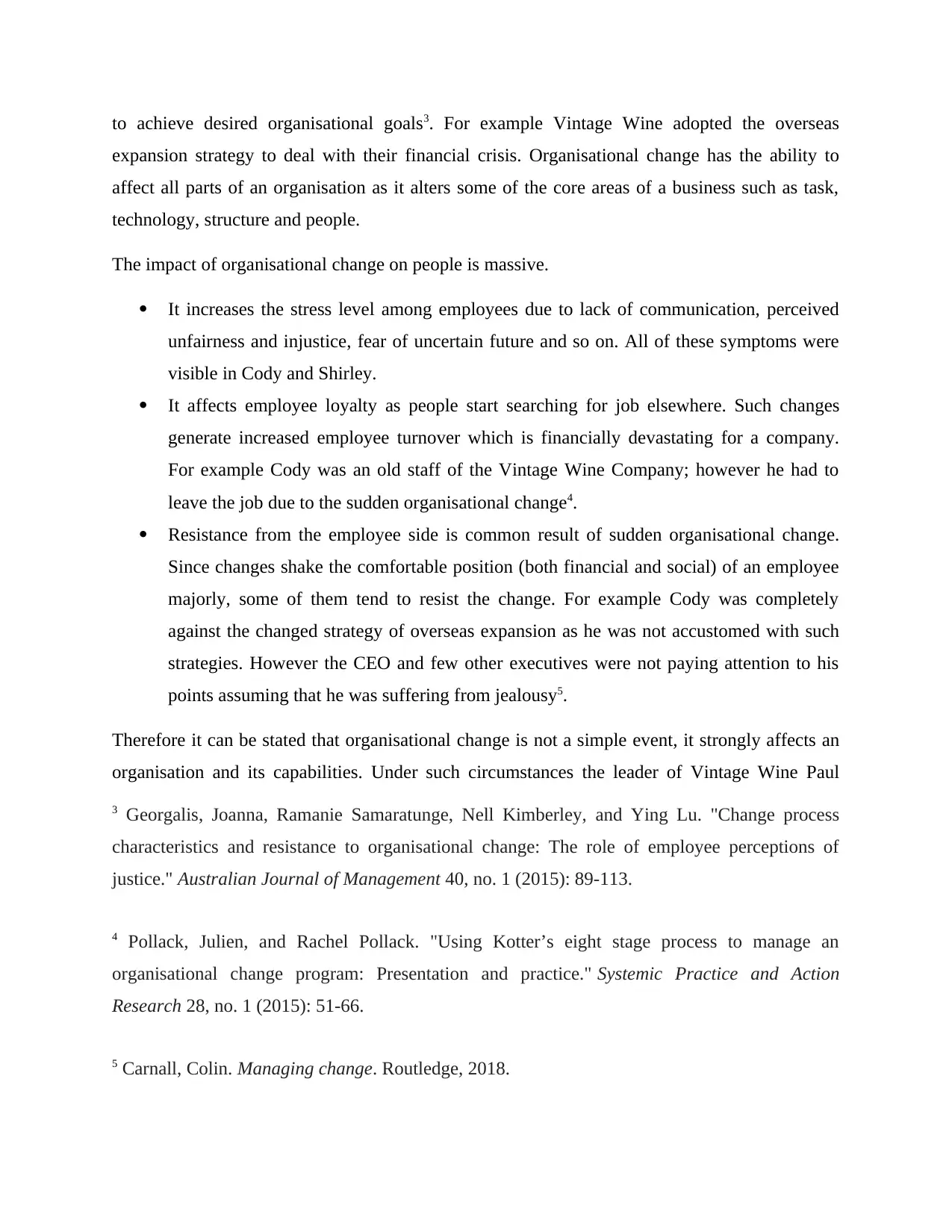
to achieve desired organisational goals3. For example Vintage Wine adopted the overseas
expansion strategy to deal with their financial crisis. Organisational change has the ability to
affect all parts of an organisation as it alters some of the core areas of a business such as task,
technology, structure and people.
The impact of organisational change on people is massive.
It increases the stress level among employees due to lack of communication, perceived
unfairness and injustice, fear of uncertain future and so on. All of these symptoms were
visible in Cody and Shirley.
It affects employee loyalty as people start searching for job elsewhere. Such changes
generate increased employee turnover which is financially devastating for a company.
For example Cody was an old staff of the Vintage Wine Company; however he had to
leave the job due to the sudden organisational change4.
Resistance from the employee side is common result of sudden organisational change.
Since changes shake the comfortable position (both financial and social) of an employee
majorly, some of them tend to resist the change. For example Cody was completely
against the changed strategy of overseas expansion as he was not accustomed with such
strategies. However the CEO and few other executives were not paying attention to his
points assuming that he was suffering from jealousy5.
Therefore it can be stated that organisational change is not a simple event, it strongly affects an
organisation and its capabilities. Under such circumstances the leader of Vintage Wine Paul
3 Georgalis, Joanna, Ramanie Samaratunge, Nell Kimberley, and Ying Lu. "Change process
characteristics and resistance to organisational change: The role of employee perceptions of
justice." Australian Journal of Management 40, no. 1 (2015): 89-113.
4 Pollack, Julien, and Rachel Pollack. "Using Kotter’s eight stage process to manage an
organisational change program: Presentation and practice." Systemic Practice and Action
Research 28, no. 1 (2015): 51-66.
5 Carnall, Colin. Managing change. Routledge, 2018.
expansion strategy to deal with their financial crisis. Organisational change has the ability to
affect all parts of an organisation as it alters some of the core areas of a business such as task,
technology, structure and people.
The impact of organisational change on people is massive.
It increases the stress level among employees due to lack of communication, perceived
unfairness and injustice, fear of uncertain future and so on. All of these symptoms were
visible in Cody and Shirley.
It affects employee loyalty as people start searching for job elsewhere. Such changes
generate increased employee turnover which is financially devastating for a company.
For example Cody was an old staff of the Vintage Wine Company; however he had to
leave the job due to the sudden organisational change4.
Resistance from the employee side is common result of sudden organisational change.
Since changes shake the comfortable position (both financial and social) of an employee
majorly, some of them tend to resist the change. For example Cody was completely
against the changed strategy of overseas expansion as he was not accustomed with such
strategies. However the CEO and few other executives were not paying attention to his
points assuming that he was suffering from jealousy5.
Therefore it can be stated that organisational change is not a simple event, it strongly affects an
organisation and its capabilities. Under such circumstances the leader of Vintage Wine Paul
3 Georgalis, Joanna, Ramanie Samaratunge, Nell Kimberley, and Ying Lu. "Change process
characteristics and resistance to organisational change: The role of employee perceptions of
justice." Australian Journal of Management 40, no. 1 (2015): 89-113.
4 Pollack, Julien, and Rachel Pollack. "Using Kotter’s eight stage process to manage an
organisational change program: Presentation and practice." Systemic Practice and Action
Research 28, no. 1 (2015): 51-66.
5 Carnall, Colin. Managing change. Routledge, 2018.
Paraphrase This Document
Need a fresh take? Get an instant paraphrase of this document with our AI Paraphraser
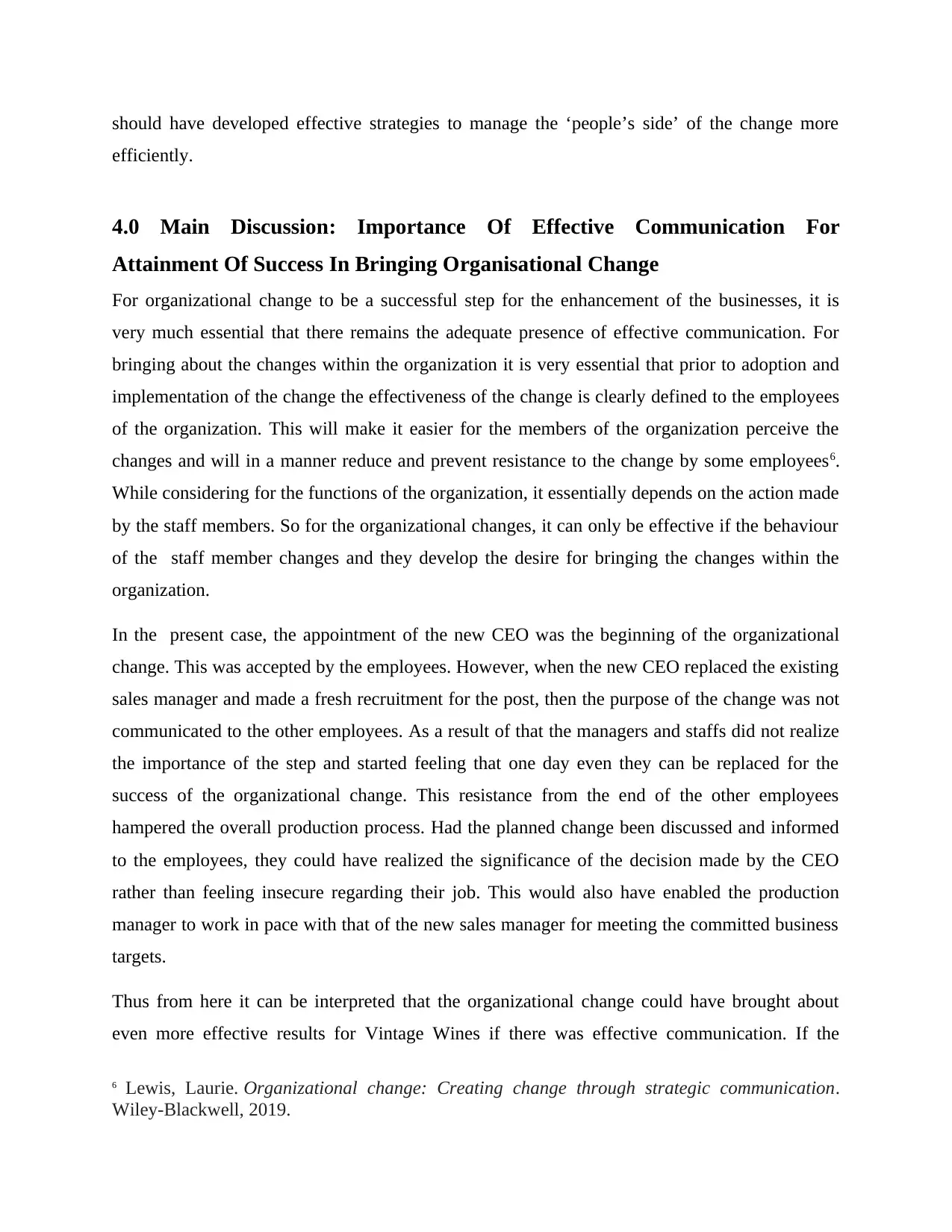
should have developed effective strategies to manage the ‘people’s side’ of the change more
efficiently.
4.0 Main Discussion: Importance Of Effective Communication For
Attainment Of Success In Bringing Organisational Change
For organizational change to be a successful step for the enhancement of the businesses, it is
very much essential that there remains the adequate presence of effective communication. For
bringing about the changes within the organization it is very essential that prior to adoption and
implementation of the change the effectiveness of the change is clearly defined to the employees
of the organization. This will make it easier for the members of the organization perceive the
changes and will in a manner reduce and prevent resistance to the change by some employees6.
While considering for the functions of the organization, it essentially depends on the action made
by the staff members. So for the organizational changes, it can only be effective if the behaviour
of the staff member changes and they develop the desire for bringing the changes within the
organization.
In the present case, the appointment of the new CEO was the beginning of the organizational
change. This was accepted by the employees. However, when the new CEO replaced the existing
sales manager and made a fresh recruitment for the post, then the purpose of the change was not
communicated to the other employees. As a result of that the managers and staffs did not realize
the importance of the step and started feeling that one day even they can be replaced for the
success of the organizational change. This resistance from the end of the other employees
hampered the overall production process. Had the planned change been discussed and informed
to the employees, they could have realized the significance of the decision made by the CEO
rather than feeling insecure regarding their job. This would also have enabled the production
manager to work in pace with that of the new sales manager for meeting the committed business
targets.
Thus from here it can be interpreted that the organizational change could have brought about
even more effective results for Vintage Wines if there was effective communication. If the
6 Lewis, Laurie. Organizational change: Creating change through strategic communication.
Wiley-Blackwell, 2019.
efficiently.
4.0 Main Discussion: Importance Of Effective Communication For
Attainment Of Success In Bringing Organisational Change
For organizational change to be a successful step for the enhancement of the businesses, it is
very much essential that there remains the adequate presence of effective communication. For
bringing about the changes within the organization it is very essential that prior to adoption and
implementation of the change the effectiveness of the change is clearly defined to the employees
of the organization. This will make it easier for the members of the organization perceive the
changes and will in a manner reduce and prevent resistance to the change by some employees6.
While considering for the functions of the organization, it essentially depends on the action made
by the staff members. So for the organizational changes, it can only be effective if the behaviour
of the staff member changes and they develop the desire for bringing the changes within the
organization.
In the present case, the appointment of the new CEO was the beginning of the organizational
change. This was accepted by the employees. However, when the new CEO replaced the existing
sales manager and made a fresh recruitment for the post, then the purpose of the change was not
communicated to the other employees. As a result of that the managers and staffs did not realize
the importance of the step and started feeling that one day even they can be replaced for the
success of the organizational change. This resistance from the end of the other employees
hampered the overall production process. Had the planned change been discussed and informed
to the employees, they could have realized the significance of the decision made by the CEO
rather than feeling insecure regarding their job. This would also have enabled the production
manager to work in pace with that of the new sales manager for meeting the committed business
targets.
Thus from here it can be interpreted that the organizational change could have brought about
even more effective results for Vintage Wines if there was effective communication. If the
6 Lewis, Laurie. Organizational change: Creating change through strategic communication.
Wiley-Blackwell, 2019.
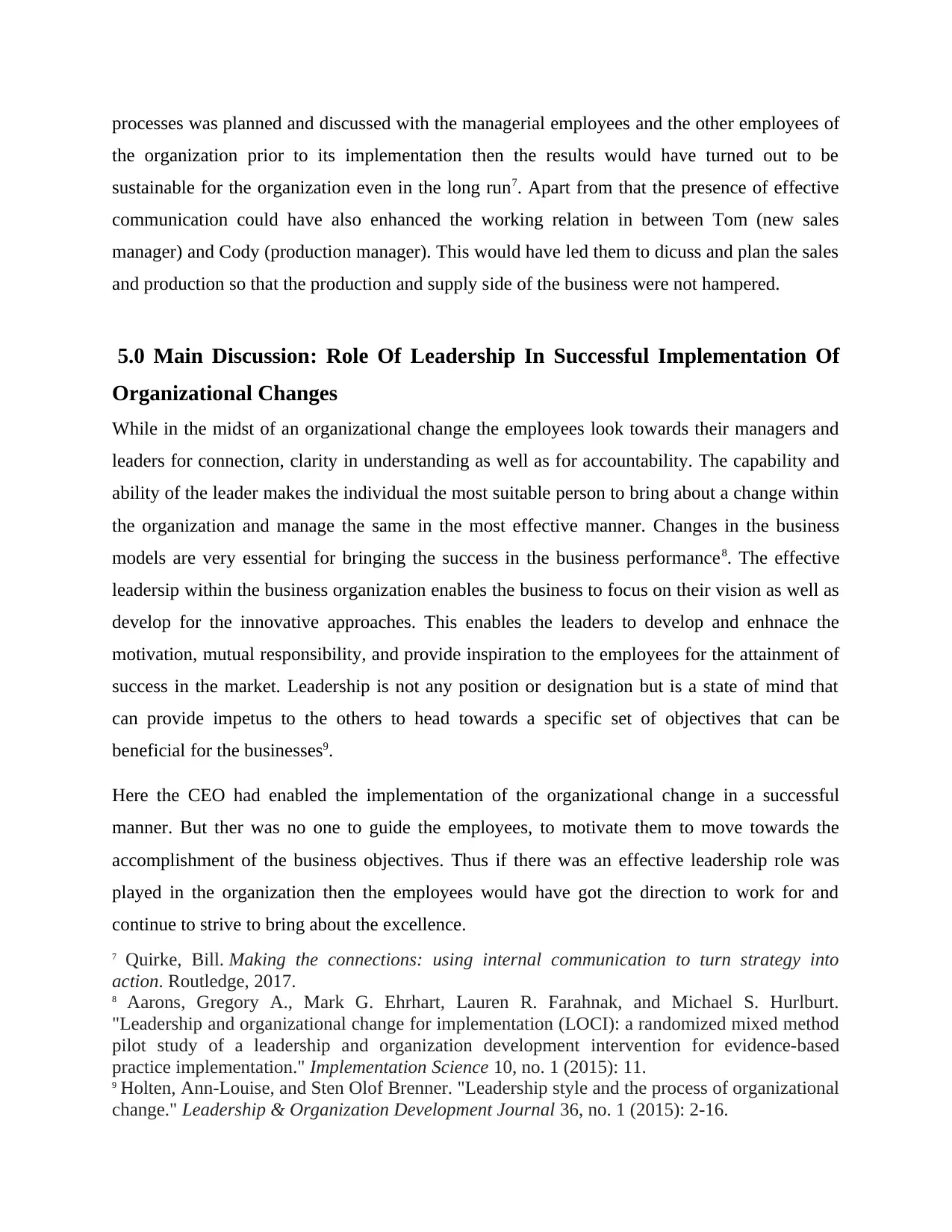
processes was planned and discussed with the managerial employees and the other employees of
the organization prior to its implementation then the results would have turned out to be
sustainable for the organization even in the long run7. Apart from that the presence of effective
communication could have also enhanced the working relation in between Tom (new sales
manager) and Cody (production manager). This would have led them to dicuss and plan the sales
and production so that the production and supply side of the business were not hampered.
5.0 Main Discussion: Role Of Leadership In Successful Implementation Of
Organizational Changes
While in the midst of an organizational change the employees look towards their managers and
leaders for connection, clarity in understanding as well as for accountability. The capability and
ability of the leader makes the individual the most suitable person to bring about a change within
the organization and manage the same in the most effective manner. Changes in the business
models are very essential for bringing the success in the business performance8. The effective
leadersip within the business organization enables the business to focus on their vision as well as
develop for the innovative approaches. This enables the leaders to develop and enhnace the
motivation, mutual responsibility, and provide inspiration to the employees for the attainment of
success in the market. Leadership is not any position or designation but is a state of mind that
can provide impetus to the others to head towards a specific set of objectives that can be
beneficial for the businesses9.
Here the CEO had enabled the implementation of the organizational change in a successful
manner. But ther was no one to guide the employees, to motivate them to move towards the
accomplishment of the business objectives. Thus if there was an effective leadership role was
played in the organization then the employees would have got the direction to work for and
continue to strive to bring about the excellence.
7 Quirke, Bill. Making the connections: using internal communication to turn strategy into
action. Routledge, 2017.
8 Aarons, Gregory A., Mark G. Ehrhart, Lauren R. Farahnak, and Michael S. Hurlburt.
"Leadership and organizational change for implementation (LOCI): a randomized mixed method
pilot study of a leadership and organization development intervention for evidence-based
practice implementation." Implementation Science 10, no. 1 (2015): 11.
9 Holten, Ann-Louise, and Sten Olof Brenner. "Leadership style and the process of organizational
change." Leadership & Organization Development Journal 36, no. 1 (2015): 2-16.
the organization prior to its implementation then the results would have turned out to be
sustainable for the organization even in the long run7. Apart from that the presence of effective
communication could have also enhanced the working relation in between Tom (new sales
manager) and Cody (production manager). This would have led them to dicuss and plan the sales
and production so that the production and supply side of the business were not hampered.
5.0 Main Discussion: Role Of Leadership In Successful Implementation Of
Organizational Changes
While in the midst of an organizational change the employees look towards their managers and
leaders for connection, clarity in understanding as well as for accountability. The capability and
ability of the leader makes the individual the most suitable person to bring about a change within
the organization and manage the same in the most effective manner. Changes in the business
models are very essential for bringing the success in the business performance8. The effective
leadersip within the business organization enables the business to focus on their vision as well as
develop for the innovative approaches. This enables the leaders to develop and enhnace the
motivation, mutual responsibility, and provide inspiration to the employees for the attainment of
success in the market. Leadership is not any position or designation but is a state of mind that
can provide impetus to the others to head towards a specific set of objectives that can be
beneficial for the businesses9.
Here the CEO had enabled the implementation of the organizational change in a successful
manner. But ther was no one to guide the employees, to motivate them to move towards the
accomplishment of the business objectives. Thus if there was an effective leadership role was
played in the organization then the employees would have got the direction to work for and
continue to strive to bring about the excellence.
7 Quirke, Bill. Making the connections: using internal communication to turn strategy into
action. Routledge, 2017.
8 Aarons, Gregory A., Mark G. Ehrhart, Lauren R. Farahnak, and Michael S. Hurlburt.
"Leadership and organizational change for implementation (LOCI): a randomized mixed method
pilot study of a leadership and organization development intervention for evidence-based
practice implementation." Implementation Science 10, no. 1 (2015): 11.
9 Holten, Ann-Louise, and Sten Olof Brenner. "Leadership style and the process of organizational
change." Leadership & Organization Development Journal 36, no. 1 (2015): 2-16.
⊘ This is a preview!⊘
Do you want full access?
Subscribe today to unlock all pages.

Trusted by 1+ million students worldwide

6.0 Main Discussion: Effectiveness Of Employee Feedback And Corrective
Action In Organizational Change
Reinforcement is a very essential as well as vital part of the overall organizational change
process. The involvement and feedback of the employees serves to be a vital part in managing
the changes introduced within the organization10. This is the key element that can develop for a
connection in between the employees and the management and the employees can share their
views and problems (if any) regarding the organizational changes. The management in turn
analyses the feedback and makes the requisite changes in action so that it can be beneficial for
the employees as well as the organization.
This entire part was major failure in regards to the organizational changes brought about in the
Vintage Wines. The organization had implemented certain change management decisions but
have never thought of taking the feedback from the employees. This would also have provided a
scope to the CEO to explain the decision made from his end and provide the requisite motivation
and inspiration to the employees to work for the attainment of the organizational success.
7.0 Recommendations
Since the business of Vintage Wines was facing troubles in its operations in the market so the
new CEO was appointed and he made the decision of change management within the
organization. But the areas where the organization was lagging behind was the presence of
effective leadership and communication within the organization. Had this been there then the
issues regarding the business operations that were raised within the organization could have been
mitigated at the workplace and the performance of the business would not have been risked.
Brining changes in the business model is an essential part for the sustenance of the business in
the present business world. So, now onwards when there will be any organizational changes
within the organization, it will be beneficial for the organization to consider the strategic style of
leadership and letting the involvement of the other employees and providing the adequate ideas,
10 Burke, W. Warner. Organization change: Theory and practice. Sage Publications, 2017.
Action In Organizational Change
Reinforcement is a very essential as well as vital part of the overall organizational change
process. The involvement and feedback of the employees serves to be a vital part in managing
the changes introduced within the organization10. This is the key element that can develop for a
connection in between the employees and the management and the employees can share their
views and problems (if any) regarding the organizational changes. The management in turn
analyses the feedback and makes the requisite changes in action so that it can be beneficial for
the employees as well as the organization.
This entire part was major failure in regards to the organizational changes brought about in the
Vintage Wines. The organization had implemented certain change management decisions but
have never thought of taking the feedback from the employees. This would also have provided a
scope to the CEO to explain the decision made from his end and provide the requisite motivation
and inspiration to the employees to work for the attainment of the organizational success.
7.0 Recommendations
Since the business of Vintage Wines was facing troubles in its operations in the market so the
new CEO was appointed and he made the decision of change management within the
organization. But the areas where the organization was lagging behind was the presence of
effective leadership and communication within the organization. Had this been there then the
issues regarding the business operations that were raised within the organization could have been
mitigated at the workplace and the performance of the business would not have been risked.
Brining changes in the business model is an essential part for the sustenance of the business in
the present business world. So, now onwards when there will be any organizational changes
within the organization, it will be beneficial for the organization to consider the strategic style of
leadership and letting the involvement of the other employees and providing the adequate ideas,
10 Burke, W. Warner. Organization change: Theory and practice. Sage Publications, 2017.
Paraphrase This Document
Need a fresh take? Get an instant paraphrase of this document with our AI Paraphraser
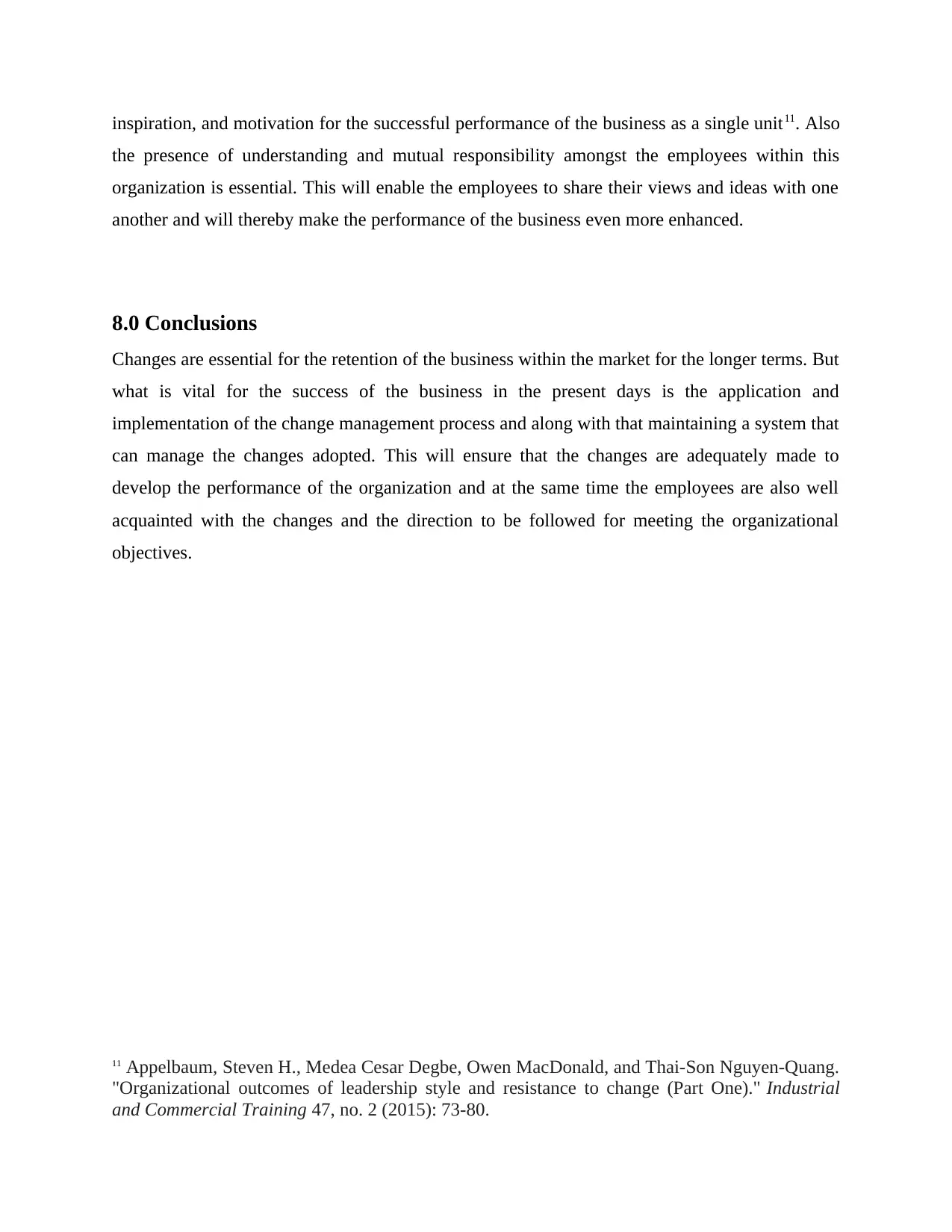
inspiration, and motivation for the successful performance of the business as a single unit11. Also
the presence of understanding and mutual responsibility amongst the employees within this
organization is essential. This will enable the employees to share their views and ideas with one
another and will thereby make the performance of the business even more enhanced.
8.0 Conclusions
Changes are essential for the retention of the business within the market for the longer terms. But
what is vital for the success of the business in the present days is the application and
implementation of the change management process and along with that maintaining a system that
can manage the changes adopted. This will ensure that the changes are adequately made to
develop the performance of the organization and at the same time the employees are also well
acquainted with the changes and the direction to be followed for meeting the organizational
objectives.
11 Appelbaum, Steven H., Medea Cesar Degbe, Owen MacDonald, and Thai-Son Nguyen-Quang.
"Organizational outcomes of leadership style and resistance to change (Part One)." Industrial
and Commercial Training 47, no. 2 (2015): 73-80.
the presence of understanding and mutual responsibility amongst the employees within this
organization is essential. This will enable the employees to share their views and ideas with one
another and will thereby make the performance of the business even more enhanced.
8.0 Conclusions
Changes are essential for the retention of the business within the market for the longer terms. But
what is vital for the success of the business in the present days is the application and
implementation of the change management process and along with that maintaining a system that
can manage the changes adopted. This will ensure that the changes are adequately made to
develop the performance of the organization and at the same time the employees are also well
acquainted with the changes and the direction to be followed for meeting the organizational
objectives.
11 Appelbaum, Steven H., Medea Cesar Degbe, Owen MacDonald, and Thai-Son Nguyen-Quang.
"Organizational outcomes of leadership style and resistance to change (Part One)." Industrial
and Commercial Training 47, no. 2 (2015): 73-80.
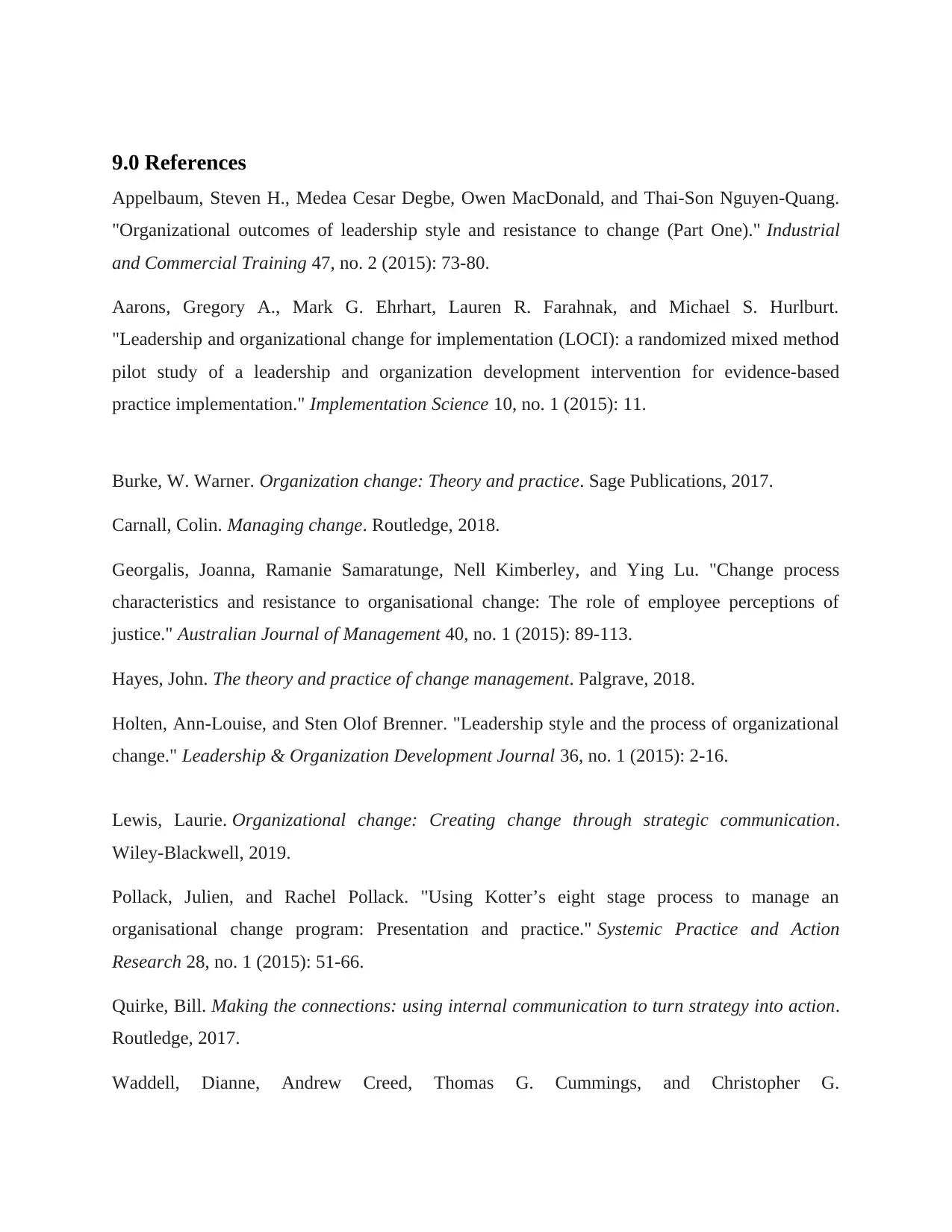
9.0 References
Appelbaum, Steven H., Medea Cesar Degbe, Owen MacDonald, and Thai-Son Nguyen-Quang.
"Organizational outcomes of leadership style and resistance to change (Part One)." Industrial
and Commercial Training 47, no. 2 (2015): 73-80.
Aarons, Gregory A., Mark G. Ehrhart, Lauren R. Farahnak, and Michael S. Hurlburt.
"Leadership and organizational change for implementation (LOCI): a randomized mixed method
pilot study of a leadership and organization development intervention for evidence-based
practice implementation." Implementation Science 10, no. 1 (2015): 11.
Burke, W. Warner. Organization change: Theory and practice. Sage Publications, 2017.
Carnall, Colin. Managing change. Routledge, 2018.
Georgalis, Joanna, Ramanie Samaratunge, Nell Kimberley, and Ying Lu. "Change process
characteristics and resistance to organisational change: The role of employee perceptions of
justice." Australian Journal of Management 40, no. 1 (2015): 89-113.
Hayes, John. The theory and practice of change management. Palgrave, 2018.
Holten, Ann-Louise, and Sten Olof Brenner. "Leadership style and the process of organizational
change." Leadership & Organization Development Journal 36, no. 1 (2015): 2-16.
Lewis, Laurie. Organizational change: Creating change through strategic communication.
Wiley-Blackwell, 2019.
Pollack, Julien, and Rachel Pollack. "Using Kotter’s eight stage process to manage an
organisational change program: Presentation and practice." Systemic Practice and Action
Research 28, no. 1 (2015): 51-66.
Quirke, Bill. Making the connections: using internal communication to turn strategy into action.
Routledge, 2017.
Waddell, Dianne, Andrew Creed, Thomas G. Cummings, and Christopher G.
Appelbaum, Steven H., Medea Cesar Degbe, Owen MacDonald, and Thai-Son Nguyen-Quang.
"Organizational outcomes of leadership style and resistance to change (Part One)." Industrial
and Commercial Training 47, no. 2 (2015): 73-80.
Aarons, Gregory A., Mark G. Ehrhart, Lauren R. Farahnak, and Michael S. Hurlburt.
"Leadership and organizational change for implementation (LOCI): a randomized mixed method
pilot study of a leadership and organization development intervention for evidence-based
practice implementation." Implementation Science 10, no. 1 (2015): 11.
Burke, W. Warner. Organization change: Theory and practice. Sage Publications, 2017.
Carnall, Colin. Managing change. Routledge, 2018.
Georgalis, Joanna, Ramanie Samaratunge, Nell Kimberley, and Ying Lu. "Change process
characteristics and resistance to organisational change: The role of employee perceptions of
justice." Australian Journal of Management 40, no. 1 (2015): 89-113.
Hayes, John. The theory and practice of change management. Palgrave, 2018.
Holten, Ann-Louise, and Sten Olof Brenner. "Leadership style and the process of organizational
change." Leadership & Organization Development Journal 36, no. 1 (2015): 2-16.
Lewis, Laurie. Organizational change: Creating change through strategic communication.
Wiley-Blackwell, 2019.
Pollack, Julien, and Rachel Pollack. "Using Kotter’s eight stage process to manage an
organisational change program: Presentation and practice." Systemic Practice and Action
Research 28, no. 1 (2015): 51-66.
Quirke, Bill. Making the connections: using internal communication to turn strategy into action.
Routledge, 2017.
Waddell, Dianne, Andrew Creed, Thomas G. Cummings, and Christopher G.
⊘ This is a preview!⊘
Do you want full access?
Subscribe today to unlock all pages.

Trusted by 1+ million students worldwide
1 out of 13
Related Documents
Your All-in-One AI-Powered Toolkit for Academic Success.
+13062052269
info@desklib.com
Available 24*7 on WhatsApp / Email
![[object Object]](/_next/static/media/star-bottom.7253800d.svg)
Unlock your academic potential
Copyright © 2020–2025 A2Z Services. All Rights Reserved. Developed and managed by ZUCOL.





